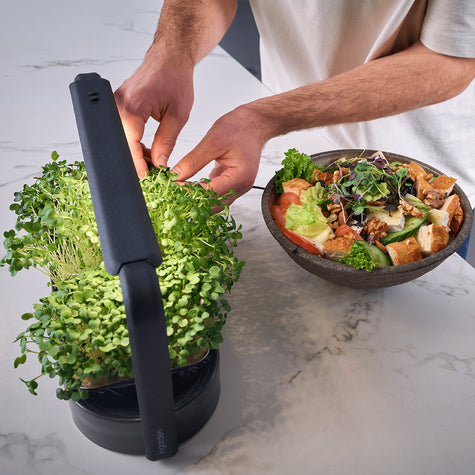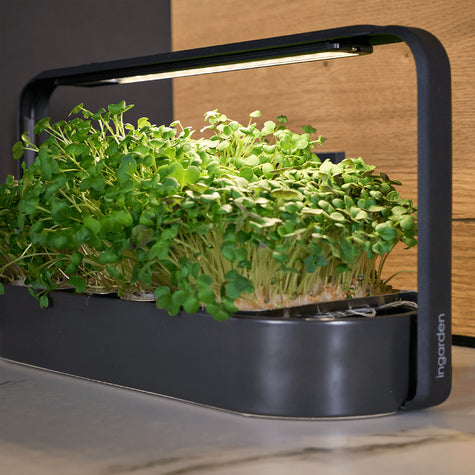In recent years, microgreens have gained significant attention due to their impressive nutritional profile and health benefits. These tiny, young plants are packed with vitamins, minerals, and antioxidants, making them a favorite among health-conscious individuals and food enthusiasts. Among the various types of microgreens , broccoli microgreens stand out for their exceptional nutritional value—particularly their high concentration of sulforaphane, a powerful compound known for its potentially health-promoting properties.
If you're new to microgreens or looking to maximize the health benefits of your diet, broccoli microgreens could be the turning point you've been searching for. In this comprehensive guide, we'll delve into the power of sulforaphane in broccoli microgreens, explore its health benefits, and show you why incorporating these tiny greens into your diet can make a big difference to your overall well-being.
What are broccoli microgreens?
Microgreens are young, edible plants harvested at an early stage of growth, typically shortly after the first true leaves (cotyledons) have formed. These miniature plants can be harvested within a few weeks, which distinguishes them from mature vegetables that take months to ripen. Despite their small size, microgreens are nutrient-dense, offering a concentrated dose of vitamins, minerals, and antioxidants that are beneficial to health.
Broccoli microgreens are the young seedlings of the broccoli plant. These greens are typically harvested within 7-14 days of germination, making them an ideal option for quick, nutrient-rich additions to your meals. Unlike mature broccoli, which has a larger, firmer texture, broccoli microgreens are tender and delicate, with soft stems and small, round leaves.
One of the biggest advantages of growing broccoli microgreens is their versatility in the kitchen. These greens can be used in a wide variety of recipes, from simple salads and sandwiches to smoothies and garnishes. Their mild flavor complements most dishes, enhancing both taste and nutritional value without overpowering other ingredients. Furthermore, they are easy to grow indoors, requiring little space, light, and care, making them an excellent option for home gardeners looking to boost their health with minimal effort.
What is sulforaphane?
Sulforaphane is a naturally occurring compound found in cruciferous vegetables such as broccoli, cabbage, cauliflower, and kale. It belongs to a class of secondary plant compounds known as isothiocyanates , which are formed when these vegetables are crushed, chewed, or otherwise broken down. Sulforaphane is particularly abundant in young plants such as broccoli microgreens, which contain up to 10 to 50 times more sulforaphane than mature broccoli .
One of sulforaphane's best-known properties is its potent antioxidant effect. As an antioxidant, sulforaphane helps neutralize harmful free radicals in the body, which can otherwise lead to oxidative stress—a condition that accelerates aging and contributes to chronic diseases. By reducing oxidative stress, sulforaphane protects cells from damage, thus supporting overall health and longevity.
In addition to its antioxidant effects, sulforaphane also has strong anti-inflammatory properties. Chronic inflammation is linked to various health problems, including heart disease, arthritis, and diabetes. Sulforaphane helps regulate the body's inflammatory response, which may reduce the risk of these conditions. By regulating inflammation, sulforaphane contributes to better joint health, improved cardiovascular function, and a more balanced metabolism.
Sulforaphane is also known for its detoxifying properties. It activates certain enzymes in the liver that aid in the breakdown and elimination of toxins from the body. This detoxification process is crucial for maintaining a clean and efficient system and helps remove potentially harmful substances before they can cause damage.
Beyond this key role, sulforaphane is the subject of numerous studies due to its potential health benefits, including:
- Supporting the health of the immune system: Sulforaphane can help strengthen the body's own immune defenses by increasing the activity of immune cells and making the body more resistant to infections and diseases.
- Reducing cancer risk: Some research suggests that sulforaphane may play a role in reducing the risk of certain cancers (Kaiser & Baniasadi, 2021), particularly by promoting the detoxification of carcinogens (Zhou & Yang, 2018) and inhibiting the growth of cancer cells (Cipolia & Mandron, 2015).
- Improvement of cardiovascular health: By reducing inflammation, oxidative stress and promoting healthy blood vessel function, sulforaphane can contribute to a healthier cardiovascular system.
The remarkable benefits of sulforaphane make it an important compound for anyone looking to improve their overall health and reduce the risk of chronic diseases. When it comes to getting a strong dose of sulforaphane, broccoli microgreens are one of the best sources available.
Why broccoli microgreens are the ideal source of sulforaphane
When it comes to maximizing your intake of sulforaphane and other beneficial nutrients, broccoli microgreens are an ideal choice. Below, we'll explain why this tiny vegetable is an excellent source of this powerful substance and why it should be part of your health regimen.
1) The nutrient density of microgreens compared to mature vegetables
One of the most remarkable aspects of broccoli microgreens is their nutrient density. Despite their small size, microgreens contain an exceptionally high number of nutrients per gram compared to their mature counterparts. Studies have shown that microgreens can contain up to 40 times more nutrients than the mature vegetable from which they are grown.
Broccoli microgreens, for example, are rich in vitamins, minerals, and antioxidants, including vitamins C and K, calcium, magnesium, and iron. They also contain sulforaphane (100 g contains 10–50 mg of sulforaphane). These nutrients promote overall health and support, among other things, the immune system and bone health. In comparison, while also very nutrient-dense, mature broccoli contains fewer nutrients per serving than the microgreens.
The sulforaphane concentration in broccoli microgreens can be optimized by chopping them and letting them rest for 40 minutes before cooking. This allows the enzyme myrosinase to convert glucoraphanin into sulforaphane.
Thanks to their high nutrient concentration, broccoli microgreens are a true superfood, offering maximum health benefits in small portions. Just a small handful of microgreens in your daily diet can significantly increase your intake of important vitamins and antioxidants.
2) Easy cultivation of broccoli microgreens for year-round access to sulforaphane
Another significant advantage of broccoli microgreens is their ease of indoor cultivation, providing year-round access to sulforaphane and other nutrients. Unlike mature broccoli, which requires ample garden space and a long growing season, microgreens can be grown indoors in a small container with minimal equipment.
Indoor gardening allows for a continuous supply of fresh, nutrient-rich microgreens, regardless of the season. Whether winter or summer, broccoli microgreens can be harvested within just 7 to 14 days, providing a consistent year-round source of sulforaphane and other health-promoting compounds.
For people living in apartments, urban areas, or regions with harsh climates, indoor gardening offers a practical solution for growing their own vegetables. With a small microgreen garden on a windowsill or under grow lights, broccoli microgreens can easily be incorporated into the diet without the need for an outdoor space or special gardening skills.
3) Sustainability and health benefits of microgreens compared to other sources
Besides its health benefits, broccoli microgreens are a sustainable and environmentally friendly food source. Growing microgreens at home has a smaller ecological footprint compared to buying fully grown vegetables, which require significant resources such as water, land, and transportation. Microgreens need very little water, and their rapid growth cycle allows for the production of more food in less time with less effort.
Growing your own microgreens promotes sustainability by reducing food waste. Unlike fully grown vegetables, which can spoil quickly, microgreens are harvested and consumed within a short time, ensuring they are eaten fresh. Furthermore, microgreens can be grown in small containers, making them an ideal option for people with limited space or those looking to reduce their carbon footprint.
In addition to their sustainability, microgreens offer significant health benefits compared to other sulforaphane sources. While mature cruciferous vegetables like broccoli, cauliflower, and kale are also healthy, broccoli microgreens contain a higher concentration of sulforaphane. This allows you to achieve maximum health benefits with a smaller portion. Regularly incorporating microgreens into your diet not only increases your intake of this potent compound but also makes a sustainable and health-conscious choice.
Conclusion
In summary, broccoli microgreens are a true nutritional powerhouse, offering an exceptional concentration of sulforaphane – a compound known for its antioxidant, anti-inflammatory, and detoxifying properties. With their ability to combat oxidative stress, reduce inflammation, support cancer prevention, and boost the immune system and cardiovascular health, these little plants make a significant contribution to overall well-being.
The benefits of broccoli microgreens extend beyond their impressive nutritional profile. They are easy to grow indoors and provide year-round access to sulforaphane without requiring much garden space. Furthermore, they are a sustainable, eco-friendly choice for anyone looking to improve their diet while minimizing their environmental footprint.
Whether you want to grow your own broccoli microgreens at home or simply incorporate them into your meals, the opportunity to improve your health is within reach. Give it a try! Start growing broccoli microgreens today . Whether you're a beginner gardener or an experienced foodie, integrating these superfoods into your daily routine is a simple and effective way to boost your health, microgreen by microgreen.







